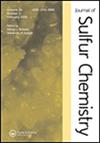n -甲基-p,对-二苯基- n -(2-吡啶基)磷硫代酰胺螯合配体:新型Hg(II)金属配合物的合成、表征和x射线结构
IF 1.6
3区 化学
Q3 CHEMISTRY, MULTIDISCIPLINARY
引用次数: 0
摘要
在回流甲苯中,n -甲基-P,对-二苯基- n -(2-吡啶基)磷酰胺与单质硫氧化生成相应的硫化物C6H3N-2-N(CH3)(P(S)Ph2)(1)配体。1与等摩尔量的HgX2 (X = Cl, I)反应生成顺式-[HgX2{1-κ 2s,Npy}] (X = Cl(2), I(3))配合物。另外,副产物Ph2P(S2)。C6H4N(CH3)(H)(4)在配体1制备过程中被鉴定出来。用多核磁共振(1H, 13C和31P)和红外光谱对1-4进行了表征。用单x射线晶体学测定了1-4的分子结构。2和3是具有结构特征的新型κ2S, npy双齿配体,具有Hg(II)金属配合物。本文章由计算机程序翻译,如有差异,请以英文原文为准。
N-methyl-P,P-diphenyl-N-(2-pyridinyl)phosphinothioic amide chelating ligand: synthesis, characterization, and X-ray structures of novel Hg(II) metal complexes
N-methyl-P,P-diphenyl-N-(2-pyridinyl)phosphinous amide was oxidized with elemental sulfur in refluxing toluene to produce the corresponding sulfide C6H3N-2-N(CH3)(P(S)Ph2) (1) ligand. The reaction of 1 with an equimolar quantity of HgX2 (X = Cl, I) produced cis-[HgX2{1-κ2S,Npy }] (X = Cl(2), I(3)) complexes. In addition, the side product Ph2P(S2).C6H4N(CH3)(H) (4) was identified while ligand 1 was being prepared. 1–4 were characterized using multinuclear NMR (1H, 13C, and 31P) and IR spectroscopy. The molecular structures of 1–4 were determined using a single X-ray crystallography. 2 and 3 are structurally characterized novel κ2S,Npy-bidentate ligands with Hg(II) metal complexes.
求助全文
通过发布文献求助,成功后即可免费获取论文全文。
去求助
来源期刊

Journal of Sulfur Chemistry
CHEMISTRY, MULTIDISCIPLINARY-
CiteScore
4.10
自引率
9.10%
发文量
38
审稿时长
6-12 weeks
期刊介绍:
The Journal of Sulfur Chemistry is an international journal for the dissemination of scientific results in the rapidly expanding realm of sulfur chemistry. The journal publishes high quality reviews, full papers and communications in the following areas: organic and inorganic chemistry, industrial chemistry, materials and polymer chemistry, biological chemistry and interdisciplinary studies directly related to sulfur science.
Papers outlining theoretical, physical, mechanistic or synthetic studies pertaining to sulfur chemistry are welcome. Hence the target audience is made up of academic and industrial chemists with peripheral or focused interests in sulfur chemistry. Manuscripts that truly define the aims of the journal include, but are not limited to, those that offer: a) innovative use of sulfur reagents; b) new synthetic approaches to sulfur-containing biomolecules, materials or organic and organometallic compounds; c) theoretical and physical studies that facilitate the understanding of sulfur structure, bonding or reactivity; d) catalytic, selective, synthetically useful or noteworthy transformations of sulfur containing molecules; e) industrial applications of sulfur chemistry; f) unique sulfur atom or molecule involvement in interfacial phenomena; g) descriptions of solid phase or combinatorial methods involving sulfur containing substrates. Submissions pertaining to related atoms such as selenium and tellurium are also welcome. Articles offering routine heterocycle formation through established reactions of sulfur containing substrates are outside the scope of the journal.
 求助内容:
求助内容: 应助结果提醒方式:
应助结果提醒方式:


